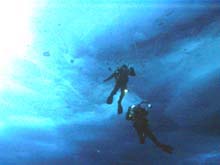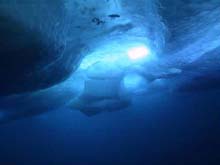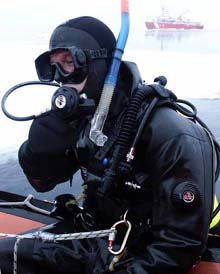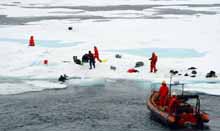
Photo of two divers under the ice as the ROV returns from a dive to 2800m. (Image courtesy of Emory Kristof.) Click image for larger view.

Above water level, the ice surface is seen as an expansive white plane. Under the water, ice morphology is very different. Various textures, thickness, and strange ice formations are readily visible to divers. (Photo courtesy of Rolf Gradinger.) Click image for larger view.
Photographing under the Ice
August 30, 2002
Paul Nicklen
National Geographic Photographer
![]() Catch a glimpse of what the divers see under the ice. (mp4, 2.6 MB) (Footage courtesy of Emory Kristof, National Geographic.)
Catch a glimpse of what the divers see under the ice. (mp4, 2.6 MB) (Footage courtesy of Emory Kristof, National Geographic.)
Photographing an underwater story for National Geographic Magazine is logistically challenging. Photographing a story under the ice in the high arctic can be a logistical nightmare. Heavy weight belts, twin tanks, dive safety lines, multiple camera housings, powerful dive lights, ice screws and portable compressors are just some of the basic gear requirements.
Today, we are diving in a location where the bottom is in excess of 10,000 feet below and the ice cover can be up to 40 feet thick. Maintaining neutral buoyancy is essential, but this environment could not make it any more challenging. Because the water temperature is -1.5 C, we have to wear extra-thick undergarments under our drysuits. As we descend in the water column, the undergarments compress with the increasing pressure. We soon find ourselves extremely heavy in the water and sinking quickly. To compensate for this compression, we have to add a lot of air to our Buoyancy Control Devices and drysuits. However, we must also be careful not to put too much air into our systems, or we could rocket to the surface and find ourselves pinned under the ice.
Vertical movements in the water column must be cautious and slow. This already challenging situation is further complicated by putting a camera up to your mask and closing one eye. It’s practically impossible to gauge whether or not you are slowly sinking or rising. Wearing extra-thick gloves means that handling buoyancy compensators, dry suit inflation, and exhaust valves becomes even more tedious.
So why take such risks and endure so many complications to photograph and dive under Arctic ice? The answer is simple. Once we plunge through the ice and descend below the frozen surface, we instantly become weightless and are greeted with a mosaic of stunning ice colors and formations. The visibility is unmatched in the world. We can see more than 400 feet in every direction—from the dark abyss to the castles of blue ice in every shape and formation. With such scenery and water clarity, thoughts of cumbersome gear and cold water instantly disappear.
Once the complications are mastered or at least controlled, it is time to shoot images that will ultimately tell a story about Arctic science. Because I was once a biologist doing research on Arctic wildlife, I now enjoy bridging the gap between scientists and the general public, using a vehicle such as National Geographic Magazine. Creating awareness to science and conservation issues is key to bringing about change. Hopefully, my dive team and I can do justice to this important arctic research.

Diving Supervisor Jeremy Stewart prepares to plunge into the icy Arctic water from the CCGS Louis St. Laurent’s Zodiac Fast Recovery Craft (FRC). Click image for larger view.

The dive station looks to be a flurry of activity in an otherwise barren landscape. In the photo, one diver, attached to the safety line, has already entered the water. The second diver with a red and black drysuit waits while the Dive Supervisor prepares his gear. The second dive tender strides across the ice, while the polar bear observer stands at watch on the left side of the photo. (Photo courtesy of Quing Zhang.) Click image for larger view.
Interview with Jeremy Stewart, 2002 Arctic Exploration Diving Supervisor
What is ice diving?
For the purpose of this expedition, we define ice diving as any dive conducted in, through, under or in the vicinity of ice.
Are there additional risks associated with ice diving?
There is always increased risk of entrapment when diving in an “overhead environment.” Caves and shipwrecks are other examples of this type of environment. Neither allow for direct access to the surface. Divers must also pay close attention to buoyancy control in order to avoid impact with the underside of the ice. Extremely cold air and water temperatures must also be considered.
What additional equipment is required for ice diving?
Drysuits are essential for effective ice diving operations. Without a drysuit, we could not remain in these frigid waters for very long.
Special cold-water regulators help prevent regulator free-flow—which is when ice forms around a regulator’s first or second stage. This causes the regulator to send a continuous stream of air, quickly depleting the diver’s supply. We use regulators that are specially designed for use in cold water and provide protection against this potential problem. Also, each diver has a second complete air supply. For this exploration, we are using 13CuFt pony bottles with independent regulators.
Because of the potential hazards associated with working under the ice, each diver is always attached to the surface with a safety line. The 150-ft. line is connected to the diver’s harness with a carabineer—a tool commonly used in rock climbing. The other end is anchored into the ice with a specially designed ice screw. If the divers become too cold or exhausted, caught in a strong current, or disoriented under the ice, the line tenders can safely bring them back to the surface.
How many people make up the 2002 Arctic Exploration Dive Team? And what are each dive team members’ responsibilities?Our team consists of five people: three divers and two line tenders. When two divers are in the water, a standby diver waits at the surface half-dressed, ready to deploy in an emergency. Each diver in the water has a tender who is responsible for helping him dress and for monitoring his safety line.
Have you experienced any problems so far?
The only incident occurred two days ago, when a 2-knot current suddenly appeared during our dive. There were two divers in the water, one taking still photos and the other running backup. They were about 20 to 30-ft. horizontal distance under the ice and around 30-ft. deep. The current started sweeping them both farther under the ice. The divers tried kicking themselves out from under the ice but were not making much progress. So they signaled for help using their safety lines and the line tenders pulled them back to the surface. Everyone did their job and the divers were fine.
What is it like underneath the Arctic ice?
It’s breathtaking. Video clips and still photos can’t possibly do it justice. The ice underwater looks completely different than the portion that extends above the surface. There is an amazing diversity of textures down there, parts that are bumpy, jagged, and sharp. Pressure ridges shoot into the water column, creating underwater ice stalactites. Amazingly, the visibility so far has been around 400-ft.—much clearer than you typically find in the tropics.
Sign up for the Ocean Explorer E-mail Update List.


























